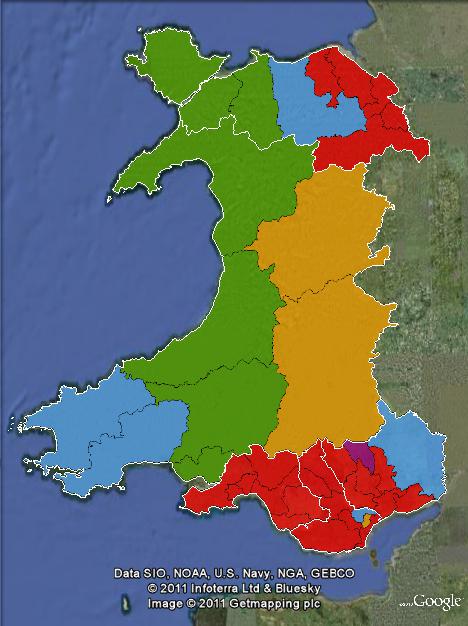On Thursday 5 May, Welsh voters will go to the polls for the fourth time to elect members of the National Assembly of Wales.
The Assembly was created in 1999 as part of a process of devolution which also saw the creation of a Parliament in Scotland, the Greater London Assembly, and the restoration of a devolved Assembly in Northern Ireland.
The Welsh Assembly consists of 60 members. Forty are elected to represent the same constituencies used for Westminster elections. The remaining twenty are elected as “top-up” members for five regions.

Each region covers seven to nine constituencies, and elects four “top-up” members to make the overall result more proportional, using the Mixed Member Proportional system used in New Zealand. Unlike New Zealand, the small number of seats available per region means that small parties do not usually win seats, with most top-up seats going to the larger parties to balance out the bias in the constituencies.
At the first election in 1999, the Labour Party won almost half the seats in the Assembly, with Plaid Cymru winning the next largest number of seats, followed by the Conservatives and the Liberal Democrats. The same pattern was maintained in 2003 and 2007, with Labour reaching a peak of 30 seats in 2003. Labour has traditionally dominated the constituency results, winning a significant majority of those races and winning little to no top-up seats.
In 2007, the result was:
- Labour – 26 (24 constituency, 2 list)
- Plaid Cymru – 15 (7 constituency, 8 list)
- Conservative – 12 (5 constituency, 7 list)
- Liberal Democrats – 6 (3 constituency, 3 list)
- Independent – 1 constituency seat
Party politics in Wales largely reflects British politics. Wales has been Labour Party heartland for most of the twentieth century, with the party always winning most Welsh seats. Labour particularly dominates constituencies in South Wales and parts of North Wales.
The second party in the Welsh Assembly for the last twelve years has been Plaid Cymru. Plaid, like the Scottish National Party, advocates for an independent Welsh state. They are also in favour of short-term objectives to achieve greater devolution for the Welsh Assembly and promotion of Welsh culture.
The office of First Minister in the Assembly has been held by Labour since devolution in 1999. Labour governed in minority from 1999 to 2000, led by Alun Michael. Michael had served as Secretary of State for Wales in the UK government from 1998 until devolution, but was not popular with the local Labour Party.
Michael resigned in 2000 after a vote of no-confidence was passed in his government. Following this, Labour elected Rhodri Morgan as their party’s leader, and he formed a coalition government with the Liberal Democrats.
Following the 2003 election, Morgan’s Labour Party held 30 of 60 seats in the Assembly, and along with a deselected Labour member who had been re-elected as an independent, he formed a working majority.
The 2007 election saw Plaid Cymru and the Conservatives gain seats while Labour lost seats. Originally Plaid, the Conservatives and the Liberal Democrats looked to form a coalition government in opposition to Labour, but the talks collapsed, and Plaid went into coalition with Labour.
A referendum was held on 3 March 2011 to vest extra law-making powers in the Welsh Assembly, giving it total authority over 20 areas of law that previously had only been devolved in part to the Assembly. The referendum was a condition of the Coalition between Labour and Plaid, and was passed decisively, with 63.5% voting yes.
In recent polling, Labour appears on track for another majority government. Labour has been consistently polling around the mid-40s, with one poll showing them on 50%. Their best ever result in 2003 saw them win 40%, and they only polled 32% in 2007.
Labour’s coalition partner Plaid Cymru polling 22% in 2007, but is recently polling in the high teens, that would probably result in them losing seats. While Plaid polled less than 400 votes more than the Conservatives in 2007, they are consistently polling less in recent months. Conservatives are usually polling around 20%.
The Liberal Democrats polled almost 15% in 2007, but following a year of sharing government in Westminster with the Conservatives, they have been polling between 5% and 8%, which would likely see them lose most of their seats.



Welsh Labour is more old Labour in the Christian Socialist sense Plaid echoes this tradition Alun Michael was a Blairite and thus unpopular. Would Labour want to continue the coalition with Plaid if they had a majority?
Comments are closed.